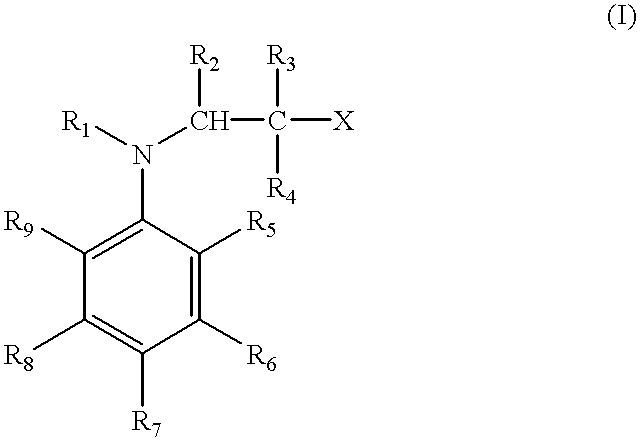Methods of curing unsaturated polymers using tertiary aromatic amine cure promoters
a technology of tertiary aromatic amine and cure promoter, which is applied in the field of curing unsaturated polymers using tertiary aromatic amine cure promoters, can solve the problems of compound effectiveness being much less effective at temperatures approaching or below 0.degree, and cannot be easily controlled, so as to achieve the effect of not adversely affecting the physical properties of the resin
- Summary
- Abstract
- Description
- Claims
- Application Information
AI Technical Summary
Benefits of technology
Problems solved by technology
Method used
Image
Examples
example 2
Synthesis of N-ethyl-N-(2-hydroxyethyl)-p-toluidine (EHPT)
N-ethyl-N-(2-hydroxyethyl)-p-toluidine (EHPT) was prepared substantially as described above in Example 1, except that acetaldehyde was added to ethylate N-(2-hydroxyethyl)-p-toluidine.
example 3
Synthesis of N-methyl-N-(2-hydroxypropyl)-p-toluidine (2HPMT)
N-methyl-p-toluidine, 29.3 g, and methanol, 50 g, were placed in a reactor. Propylene oxide, 25.4 g, was slowly added to the reactor over two hours. Afterwards, the reactor was heated under reflux for 6 hours. The low boilers were removed by distillation. Then, the mixture was vacuum distilled to give 2HPMT. The boiling point is 92.degree. C. at 5 mm Hg.
example 4
Comparison of Gel and Cure Times of MHPT and DMPT at 15.degree. C. and 25.degree. C.
The thus synthesized MHPT was compared to N,N-dimethyl-p-toluidine (DMPT) as described below with regard to gel and curing rates of an unsaturated polyester resin at varying promoter concentrations levels and varying temperatures. Benzoyl peroxide was used as a 50% dispersion in tricresyl phosphate and which was used as the initiator for the curing reaction. The polyester resin used was an unpromoted, high-reactivity resin based on ortho phthalic acid and containing 20 to 25 percent free styrene monomer, available under the trade name Polylite 44-289 from Reichhold Chemical Company.
MHPT was compared to DMPT as cure reaction promoters at five different concentrations (0.1. 0.2, 0.3. 0.4 and 0.5 percent by weight) for the unsaturated polyester resin. All the curing reactions were performed using 1% benzoyl peroxide as initiator at two different reaction temperatures (15.degree. C. and 25.degree. C.). T...
PUM
| Property | Measurement | Unit |
|---|---|---|
| temperature | aaaaa | aaaaa |
| temperature | aaaaa | aaaaa |
| temperatures | aaaaa | aaaaa |
Abstract
Description
Claims
Application Information
 Login to View More
Login to View More - R&D
- Intellectual Property
- Life Sciences
- Materials
- Tech Scout
- Unparalleled Data Quality
- Higher Quality Content
- 60% Fewer Hallucinations
Browse by: Latest US Patents, China's latest patents, Technical Efficacy Thesaurus, Application Domain, Technology Topic, Popular Technical Reports.
© 2025 PatSnap. All rights reserved.Legal|Privacy policy|Modern Slavery Act Transparency Statement|Sitemap|About US| Contact US: help@patsnap.com



